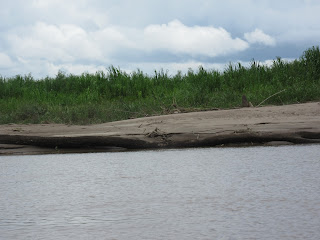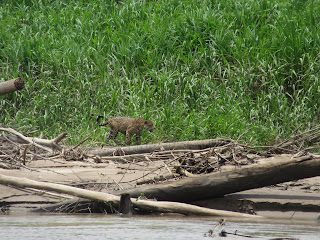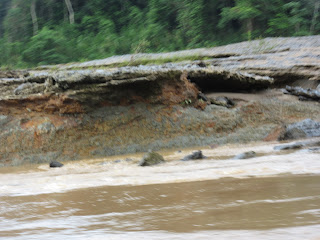After tearing ourselves from watching the macaws eat the clay lick for about 40 minutes, one of the most magnificent animal sights we'd ever seen, we returned to the boat for our journey back to the Chuncho Lodge on the Tambopata River in southeastern Peru.
A grove of cerecopia trees on the riverfront:There was a very welcome breeze on the boat ride as it had been quite humid watching the macaws for the last few hours in our long pants and shirts.
As this part of the river was located in the river's security zone, no people lived in this area.
Our guide, Jorge, asked the boatman to slow down as he had spotted an animal in the long grasses. Perhaps you can just see a brown spot in the dead middle of the photo if you click on the image to make it larger?
Sure enough, it was a jaguar, an animal Jorge said he hadn't seen for the last 2.5 months. We joked we'd brought him good luck!
We had known that lodge stays generally allowed visitors to see a large variety of trees, plants, and birds, but sightings of wild mammals, apart from monkeys and otters, were rare. Species such as jaguars and tapirs seldom show their faces. It was indeed our lucky day that we had such a clear sighting of the male jaguar.
Since it was so unusual seeing the jaguar, the boatman kindly cut the engine so we had more time to enjoy the jaguar's presence.
It wasn't long before he retreated to the grasses. This area used to be called El Gato or The Cat as many jaguars used to roam there years ago.
Jorge had to stop again at the ranger station to check us out.
A few minutes later, we passed a group of men who were panning for gold in the river, a practice that has become very controversial because of its environmental impact.
By 1 pm, we were finally back at the lodge and enjoying lunch. I say 'finally' because we had been up since 4 to set off to see the macaws at the clay lick!It was amazing to think that there were five staff members looking after us and Simon, the tourist from Australia while we were staying at the Chuncho Lodge: Jorge, a chef, a waiter, a housekeeper and the boatman! Lunch consisted of a very colorful potato and beet salad and ...
chicken, rice and potatoes wrapped in a large leaf like we'd seen the previous evening on our nature walk.
Steven, especially, was glad we then had a 90-minute siesta time before our next activity, a boat ride to a local farm.
Before leaving, we had boots to pick out that were supplied by the lodge.
Earlier that day, we had traveled upriver toward the clay lick but this time we motored downriver for a short ride.
Jorge said there were also mammal clay licks in the area which were frequented by deer and tapirs. Jaguars are sometimes spotted there, too, as they go to eat the other animals.
Hazards similar to those we'd seen earlier in the river required the boatman to go very carefully in several spots.
We were happy we had been provided with boots when we arrived at the farm's 'dock' as it was very muddy.
Jorge pointed out this avocado tree which the farmer has to shake for the ripened fruit to fall. The fallen fruit must be picked up right away as otherwise wild cuy or guinea pigs will devour them.
Each tree normally produces 150-200 avocados depending on the size of the tree.
Some people stay at Eduardo's Farm for extended periods even though it only had very basic accommodation. More on that later.
Jorge explained that since Chuncho Lodge pays Eduardo, the owner of the farm, a monthly fee to allow their guides to bring their guests to the farm, he was able to cut down one or two of each of the fruits to show us and allow us to taste them if we wanted.
We soon noticed that the farm had lots of fruit trees mixed together so there was a star fruit tree adjacent to a lemon one, next to a noni one, etc. It certainly wasn't a neat and tidy orchard like most of us would be accustomed to, but of course we were in the Amazon jungle!
The star fruit or caramabola was a little sour, unlike others I had eaten in the past. I didn't know if that was the nature of that star fruit variety, it wasn't quite ripe or what, however. A kilo of the fruit sold for just one sole in the local market, about .33!
As there were electric eels and stingrays in the water, farm visitors weren't encouraged to swim.As you might expect, Steven and I were excited to see a Pinon Colorado tree a few feet from the water!
This noni, which smelled like old cheese, was beneficial for those with diabetes once it was peeled, cut into small pieces and blended with water and then drunk.
This was a yucca plant, similar to a potato.
Near one of the lodges was a lemon tree, one of my favorite fruits to bake. Locals cook the leaves to make lemon tea.
A banana palm:
Unfortunately, I neglected to write down what this interesting looking fruit was.
Jorge used a long stick lying on the ground to dislodge oranges from this tree. We just all had to be careful that one didn't hit us in the head!
Of course, Jorge could have climbed the ladder, a more conventional approach, to collect the oranges for our breakfast in the morning! July and August was the best time for getting the most delicious orange juice.
'Fishing' for oranges!
Simon collected the booty!
Old oranges littered the undergrowth.
Jorge declared this cacao plant would be ready to harvest in another week when it was orange. Then it would be dried for one month. Peru exports cacao seeds to Belgium to make premiere chocolate.
It didn't seem as if any of the fruit trees had ever been pruned.
Jorge encouraged us to try these lemon grigoso but we found them especially sour, even for a lemon!
He warned us to stay clear of these botaly ants.
Jorge told us to wait as he counted one, two and three as if we were downing a shot so we could all try slices of this toronja lemon at the same time! It was even more bitter than the last one which I wouldn't have thought possible. Jorge assured us they were delicious on shrimp
While Steven was touching this coffee bean plant, we heard an orependula bird nearby.
When you click on these pictures, you'll see the toucan more clearly.
Somewhere in this undergrowth was another lemon tree but we wouldn't have known it except for the sign!
Another fruit we'd never heard of before was the anona. It was sweet and pleasant, unlike the varieties of lemons we'd tasted!
Small banana plants, like the one in front of Steven, grow in a circle or in groups.
When Jorge had said earlier we'd walking through a farm, traipsing through this jungle-like habitat was a far cry from what we envisioned. It was far more exciting and definitely opened our eyes and taste buds to new sensations.
Pineapple plants:
A knife stone:
The tree was full of papayas but they didn't look as if they could be enjoyed for a while yet.Jorge explained that the indigenous peoples of the Amazon basin have for centuries participated in an Ayahuasca Ceremony, in which a shaman prepares a brew made out of Banisteriopsis caapi vine and other ingredients. The brew is used as a traditional spiritual medicine in ceremonies to ward off evil spirits. I mentioned earlier in the post about the farm's basic accommodations.
The reason is that many Westerners come to the farm, as they do to other lodges in southern Peru and northern Bolivia, to participate in an Ayahuasca Ceremony so they can experience a "truly life changing and transformative experience." According to information I found online, "Ayahuasca takes you into the universe within you and shows you many things about yourself, your life, and the world."
One site, directed to Westerners, said, "Sometimes Ayahuasca has something different to show you than what you had originally intended to work on, as Ayahuasca knows what you need to focus on first in your life to clear the way for the other things you want to address. Try to surrender to whatever experience Ayahuasca gives you. The medicine always knows best what you need. Sometimes people get an unexpected experience, but just know that what Ayahuasca shows you is what is necessary for your healing or enlightenment."
The part that scared me was that it wasn't unusual "for people to feel like they are going to die when they are in an Ayahuasca experience." It didn't make me feel better when it continued "If there are deaths around Ayahuasca, it is always because the shaman put something else in the Ayahuasca that shouldn’t be there or were acting irresponsibly." Jorge said some tourists stay for a week for the Ayahuasca purification/religious ceremony. Thanks, but no thanks was all I could think of as the ceremony wasn't something I would want to participate in.
On a more joyful note, Jorge put these tiny seeds he had found on the ground in my hand, telling me to rub them together
They were a natural coloring or paint used to decorate a dress and one's face for dancing.He applied it to my several spots on my face but luckily never asked me to dance around a fire circle!
The farm's ultra basic bathroom consisted of a shower on one side and a toilet on the other.
It was hilarious watching first Simon and then Jorge take a good ten whacks each with the machete to try and open up the Brazil coconut Jorge had found yesterday on our drive through the jungle en route to Chuncho Lodge.I knew Jorge was confident he would have far more success opening it up than Simon who had never wielded a machete before, but he only managed to whack off a few pieces of one end after repeated attempts!
By 5:30, we were on the boat heading back to our lodge just as the sun was beginning to set on the Tambopata River.
The sunset was as gorgeous as the sunrise had been 12 plus hours earlier on our way to the macaw clay lick.
The visit to Eduardo's Farm had been far more than we expected - educational when learning about the many varieties of South American fruits we saw and tasted as well as the animals we spotted and heard; fascinating learning about local customs and culture; and a hoot watching Simon and Jorge trying to 'out man' each other with the machete and a lowly Brazil nut!
Next post: A long hike in the mud to another lodge in the Amazon.
Posted on January 26th, 2018, from Littleton, Colorado.











































































































Its amazing that the avocado tree can hold 150-200 fruits. Must be heavy. Lil Red
ReplyDeleteWe were also amazed one avocado tree could produce so many fruits, Lil Red.
DeleteAnnie
A Jaguar-so cool!
ReplyDeleteWe were pretty flabbergasted when the jaguar appeared out of the long grasses and just slowly walked along the riverfront for several minutes, Natalie.
DeleteXOXOX